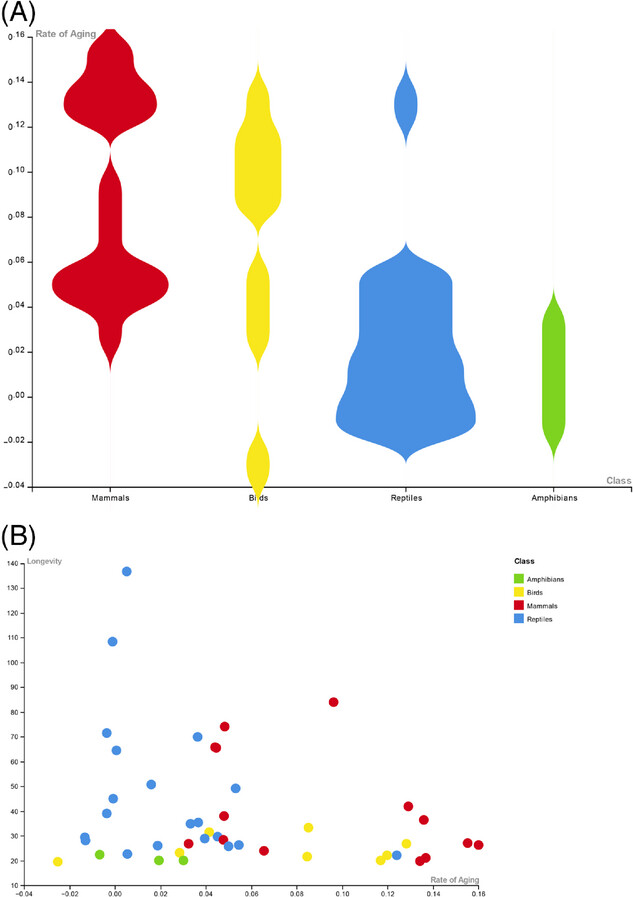If you’re not looking forward to getting old, now at least you have someone to blame: dinosaurs. According to a new study, it could be that mammals decline as they get old in a way many reptiles and amphibians do not as a side-effect of our ancestors’ strategy for not being eaten by a raptor.
There is a lot to unpack here, so let’s back up a bit. You may have seen the memes about how a Greenland Shark is not a Christmas whim but a 400-year commitment. Although these inhabitants of the icy deep take slow living to extremes, they have a certain amount of company, mostly from reptiles. Tortoises that could have met Darwin and made it into the 21st century are a prominent example.
Most reptiles, let alone amphibians, inhabit territory far more abundant in predators than the remote islands on which tortoises grow so large. Consequently, few get to reach such extravagant ages. Nevertheless, many reptiles have the capacity to live much longer than their mammalian counterparts, and do so in zoos or other safe locations, thanks to relatively little age-related decay.
Professor João Pedro de Magalhães of the University of Birmingham, UK, has flipped the usual thinking on this topic on its head. From our mammalian perspective, aging is normal, and the question is how some reptiles manage to postpone it so well. The capacity of many amphibians to recover from injuries that our furry brethren need modern medicine to repair seems nothing short of miraculous. But what, de Magalhães ponders, if we’re the unusual ones? What if the certainty of early aging is the exception, not the norm, a distinctively mammalian trait like fur or producing milk?
If so, de Magalhães proposes, perhaps it came about through millions of years of battling for survival on a planet where ferocious predators were forever after us.
de Magalhães calls the idea the “longevity bottleneck hypothesis”. Rather than being a speculative formula on how long wine can escape being drunk in the absence of a corkscrew, this refers to the idea that mammals evolved a live-fast-die-young approach in the Jurassic and Cretaceous and are still yet to fully throw it off.
“While we see humans among different species that are among the longest living animals, there are many reptiles and other animals that have a much slower ageing process and show minimal signs of senescence over their lives,” de Magalhães said in a statement. “Some of the earliest mammals were forced to live towards the bottom of the food chain, and have likely spent 100 million years during the age of the dinosaurs evolving to survive through rapid reproduction.”
In other words, if you’re going to be eaten by a Spinosaurus, it’s best to focus on breeding at the first opportunity, not ensuring you’re still fit and fertile at fifty. Come to think of it, aging may not be the only trait humans have inherited from those times.
“We see examples in the animal world of truly remarkable repair and regeneration,” de Magalhães continued. “That genetic information would have been unnecessary for early mammals that were lucky to not end up as T Rex food. While we now have a plethora of mammals including humans, whales and elephants that grow big and live long, we and these mammals live with the genetic hangups from the Mesozoic era and we age surprisingly faster than many reptiles.”
If de Magalhães is right, we may be suffering the consequences in more ways than declining reproductive capacity or running speed as we age. The idea could, for example, offer insight into why humans seem more prone to cancer than most other animals.
A comparison of the rates at which mammals, birds, reptiles and amphibians age shows there are no mammals that have the potential survival of the other four types of vertebrate.
Although de Magalhães acknowledges that many reptiles, fish, and birds also age quickly, he stresses that many don’t – whereas for mammals, rapid aging relative to size is universal, and disputes reports that naked mole rats are an exception.
He offers the photolyase DNA protection system as an example of a genetic fountain of youth known to have been lost in non-marsupial mammals during the dinosaur era. The first reasonably large mammals to evolve after the dinosaurs’ dominance ended, the pantodonts, had a lifespan short enough to puzzle paleontologists, de Magalhães notes. Gradually some mammals have thrown off some of the limitations placed by this past, de Magalhães thinks – but none have escaped it entirely.
The idea remains very much a hypothesis, rather than an established theory. It may prove hard to reconcile with the recent conclusion that dinosaurs themselves lived shorter lives than previously suspected, but de Magalhães thinks there are ways to test it.
While that process occurs, we politely request you not take out your resentment for this situation on the dinosaurs’ descendants by being cruel to a bird. Then again, in the case of chickens, it seems like humanity may already be doing just that.
The paper describing the hypothesis is published open access in Bioessays.
Source Link: Dinosaurs' Dominance May Have Left Its Mark On How Humans Age
